Easy Home Experiments Using Gas Laws
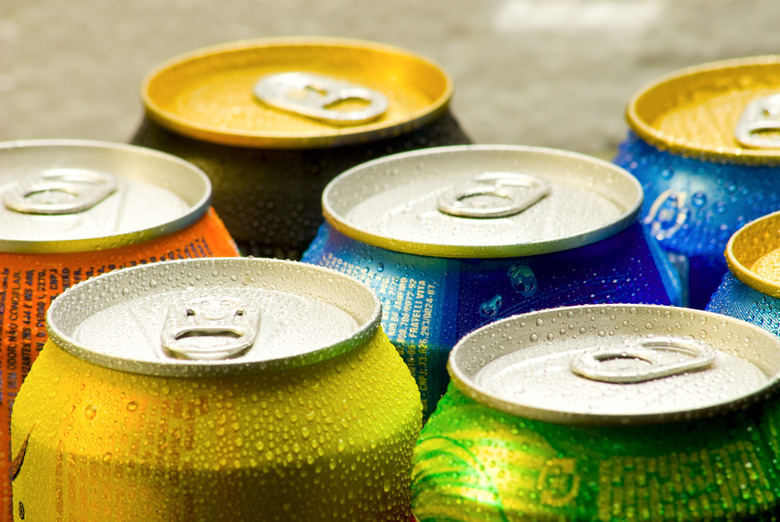
The gas laws are easy to demonstrate with everyday household items. These related scientific principles describe how the volume, pressure and temperature of a gas change under various conditions, and represent a cornerstone of chemistry and physics. A gas law experiment shows what happens to one property, such as the volume, when you change another, such as temperature, while keeping the remaining one the same. The experiments described here are safe and inexpensive and use no harmful chemicals, only air and water vapor. The same principles work for any ordinary gas.

The Can Crusher
The can crusher experiment demonstrates Charles's Law, the basic principle that gases expand when heated and contract when cooled. You will need a small soda can; fill it with about half an ounce of water. Boil the can in a pan of water for about a minute, and you will notice vapor steaming from the opening of the soda can. Using tongs, grab the can and place it upside down in a bowl of cold water. The can will crush immediately. The water vapor exits the can immediately, and cold water condenses the vapor, leaving the can at very low pressure inside. It happens so quickly that the normal air pressure outside the can crushes the exterior of the can.
The Balloon in the Bottle
Find an empty glass bottle, such as a soda bottle, and fill it with about an ounce of water. In a pan of water, heat the bottle until the water inside reaches a boil. Stretch balloon over the mouth of the bottle. As the bottle cools, the gas will suck the balloon into the bottle and it will begin to inflate inside the bottle. What is happening is that the balloon trapped the water vapor in the bottle and as it cools the outside air pressure replaces the water vapor that is now condensing and emptying the inside of the bottle. Gas expands as it heats, and shrinks as it cools, making the bottle "empty" compared to the exterior air pressure. The balloon expands inside the bottle to allow the exterior air pressure inward. This experiment provides another example of Charles's Law.
The Air Compression Experiment
This experiment demonstrates the power of compressed air. Empty a soda bottle and insert a balloon. Try to inflate the balloon inside the bottle. It is impossible because of the air sitting inside the bottle. As the balloon inflates, it squeezes the air in the bottle. The air compresses but also pushes back, like a spring. Your lungs cannot provide enough force to overcome the air pressure in the bottle. This experiment illustrates Boyle's Law, which shows that you can compress a gas, though it's not easy.
- Classroom Gas Experiments
- Georgia State University: Ideal Gas Law
Cite This Article
Beckett, Graham. "Easy Home Experiments Using Gas Laws" sciencing.com , https://www.sciencing.com/easy-experiments-using-gas-laws-5506609/. 13 March 2018.
Beckett, Graham. (2018, March 13). Easy Home Experiments Using Gas Laws. sciencing.com . Retrieved from https://www.sciencing.com/easy-experiments-using-gas-laws-5506609/
Beckett, Graham. Easy Home Experiments Using Gas Laws last modified March 24, 2022. https://www.sciencing.com/easy-experiments-using-gas-laws-5506609/
Recommended
Cool Science Experiments Headquarters
Making Science Fun, Easy to Teach and Exciting to Learn!
Science Experiments
Balloon Blow-up Science Experiment
Can you blow up a balloon without using your mouth? In this simple science experiment, we’re going to show you how to do it with only a few everyday items you probably already have in your home. It makes a great experiment for young children because the set-up is simple and it only takes a few minutes to get to the exciting finale.
In addition to a video demonstration and detailed printable instructions, we also have the scientific explanation of how this simple chemical reaction works making it perfect for older scientists too.
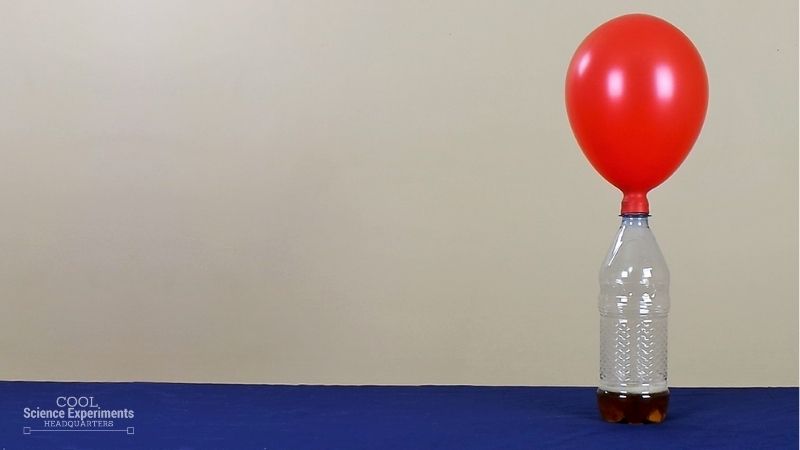
JUMP TO SECTION: Instructions | Video Tutorial | How it Works
Supplies Needed
- Small Soda Bottle
- Baking Soda

Balloon Blow-up Science Lab Kit – Only $5
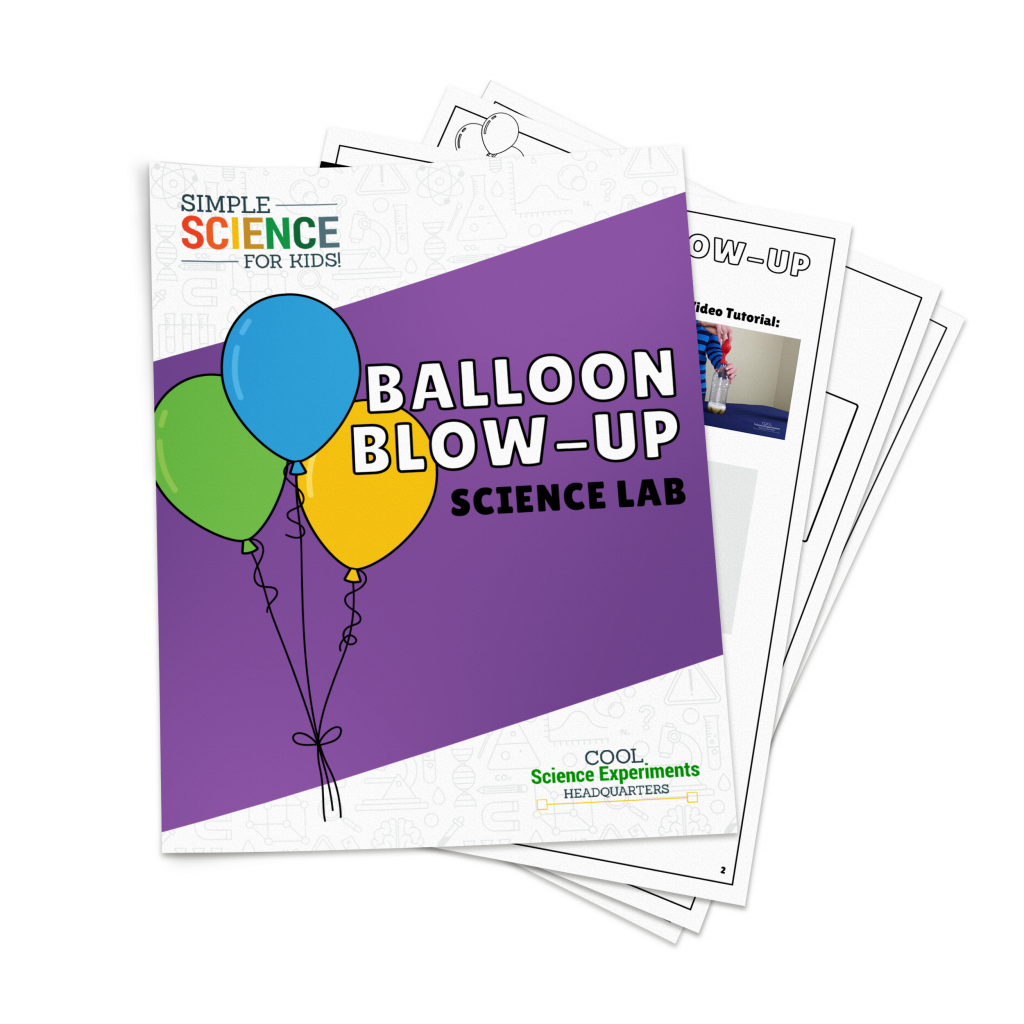
Use our easy Balloon Blow-up Science Lab Kit to grab your students’ attention without the stress of planning!
It’s everything you need to make science easy for teachers and fun for students — using inexpensive materials you probably already have in your storage closet!
Balloon Blow Up Science Experiment Instructions
Step 1 – Start with some questions: How do you blow up a balloon? What if I told you that you couldn’t blow air into it, do you think you could still inflate (blow-up) the balloon? Then observe the supplies for the experiments. Do you think they can be use to blow up the balloon? If so how? Write down your hypothesis (prediction).

Step 2 – Using a funnel, pour about a third of a cup of vinegar into the bottle. We used Apple Cider Vinegar, but any type of vinegar will work.
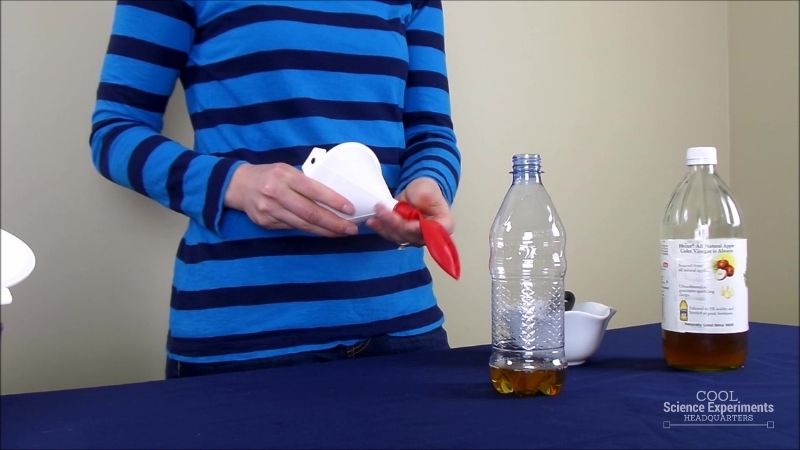
Step 3 – Then insert another funnel into the mouth of the balloon. We recommend using two different funnels. One funnel for filling the bottle with vinegar and one for the balloon. However, you can do the experiment with only one funnel. Just make sure you completely wash and dry the funnel after you add the vinegar and before you put it into the balloon. This is very important.
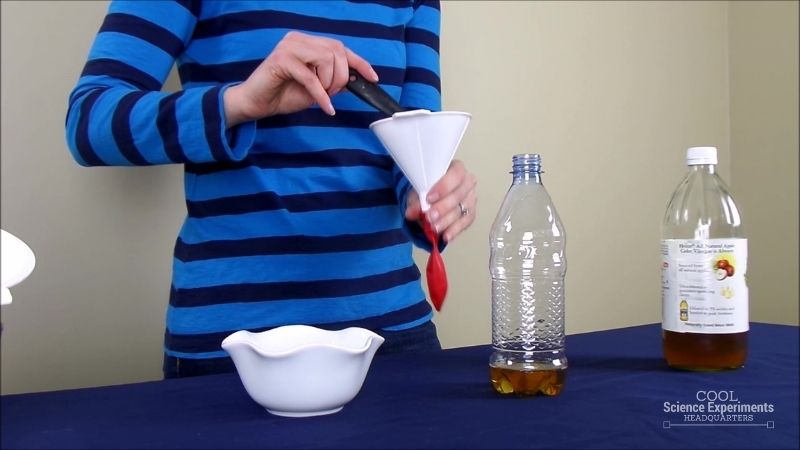
Step 4 – Place two teaspoons of baking soda into the funnel so it falls into the balloon. When the balloon is filled with the baking soda, carefully remove it from the funnel.
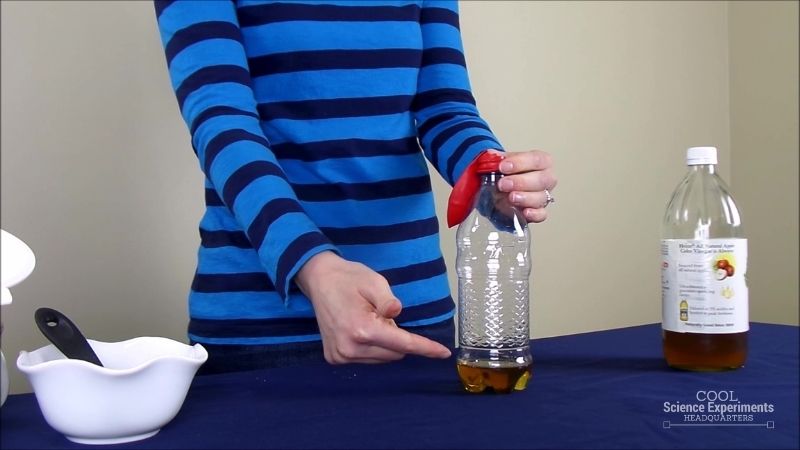
Step 5 – Next, secure the mouth of the balloon over the mouth of the bottle. Take your time doing this and don’t let any of the baking soda fall out of the balloon and into the bottom of the bottle. Take a moment to make some observations. What will happen if we lift up the balloon? Write down your hypothesis (prediction) and then test to see if you were right!
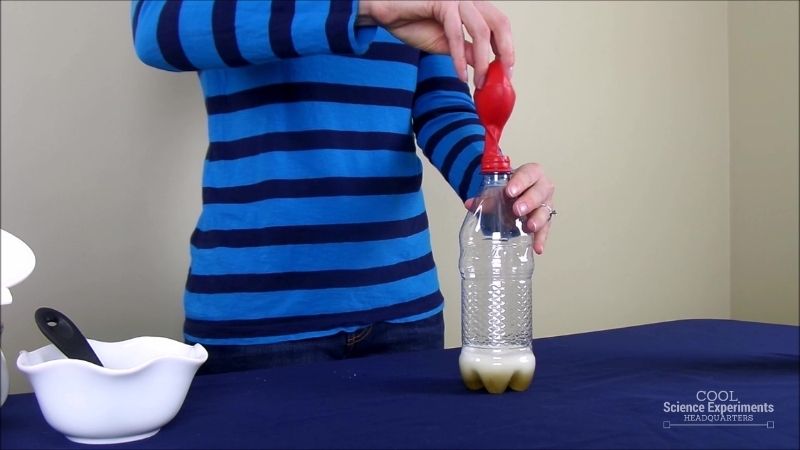
Step 6 – While holding the bottle, lift the end of the balloon and allow the baking soda to drop into the bottle.
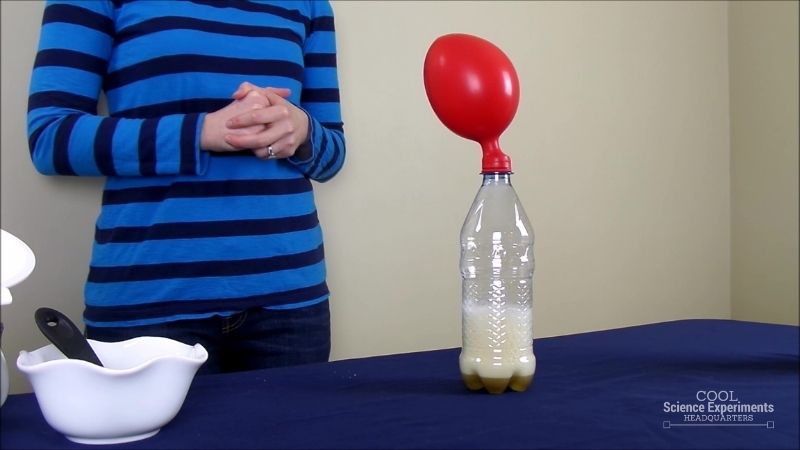
Step 7 – What happens to the balloon? Was your hypothesis correct? Wondering what caused the balloon to inflate? Find out the answer in the how does this experiment work section below.
Video Tutorial
How Does the Science Experiment Work?
When baking soda (a base) and vinegar (an acid) are mixed together they create a chemical reaction that results in the formation of carbon dioxide gas. Gases do not have a specific shape or volume, rather they expand rapidly filling their container. Gases expand rapidly because their particles move at high speeds in all directions. As the carbon dioxide gas fills the bottle, it has nowhere else to go so it begins to fill the balloon. As the carbon dioxide gas fills the balloon, the balloon inflates. The more gas that is created, the larger the balloon will inflate.
The baking soda and vinegar chemical reaction will continue to inflate the balloon as long as there is still baking soda and vinegar to react. Once the reaction between baking soda and vinegar has stopped, the balloon will slowly begin to deflate.
An acid is a substance that tastes bitter, reacts with metals and carbonates, and turns blue litmus paper red. A base is a substance that tastes bitter, feels slippery, and turns red litmus paper blue.
Other Ideas to Try
Does changing the amount of baking soda and vinegar change the size of the balloon when it inflates? What would happen if you used another acid like lemon juice instead of the vinegar? Would it react the same with the baking soda?
I hope you enjoyed the experiment. Here are some printable instructions:
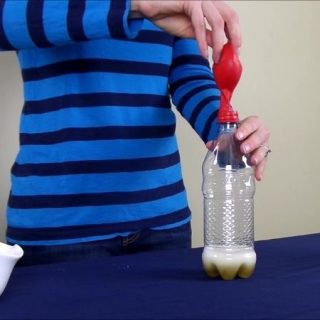
Instructions
- Using a funnel, pour about a third of a cup of vinegar into the bottle. Tip: I used Apple Cider Vinegar, but any kind of vinegar will work.
- Then insert another funnel into the mouth of the balloon. Tip: It is best to have two funnels, one for filling the bottle with vinegar and one for the balloon. If you only have one funnel, it is important that you completely wash and dry the funnel after you add the vinegar and before you put it into the balloon.
- Place two teaspoons of baking soda into the funnel so it falls into the balloon. Then remove the balloon from the funnel.
- Next, secure the the mouth of the balloon over the top of the bottle. Tip: Don’t let any of the baking soda drop into the bottle…yet!
- While holding the bottle, lift the end of the balloon allowing the baking soda to drop into the bottle.
- Watch in amazement as the balloon magically inflates!
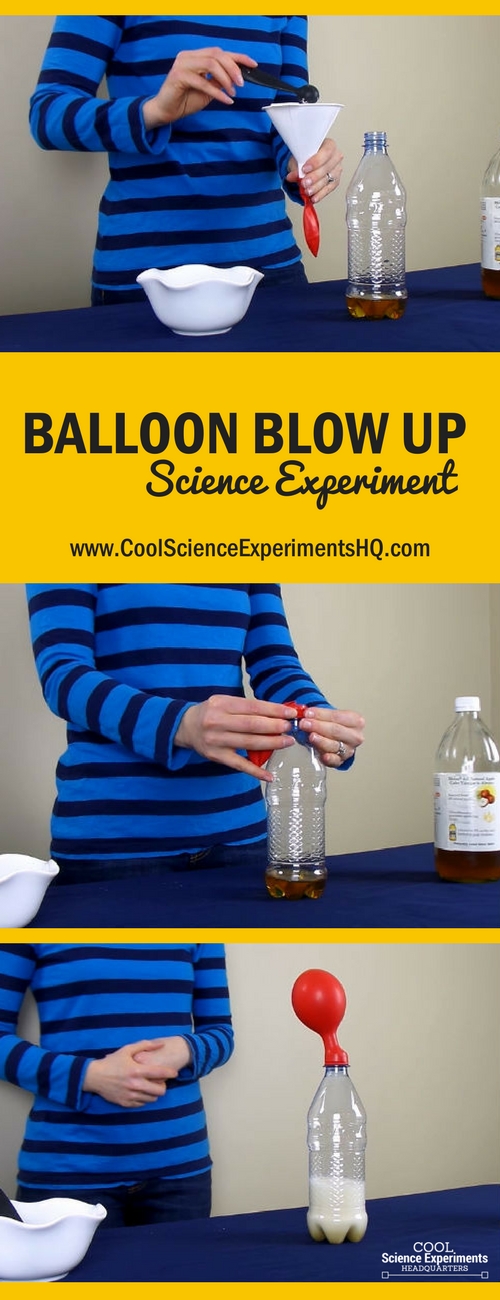
Reader Interactions
November 2, 2017 at 11:00 am
Yeah but don’t just eyeball the measurements of things because if you use to much baking soda it will make the baloon spring a leak and all sorts of stuff will fly out and make a big mess.
I speak form experience
Seriously, don’t do this
April 21, 2018 at 10:26 am
I did this experiment and it is perfect!
You need to hold properly the bottle when you mix the baking soda into vinegar.
May 22, 2019 at 8:57 am
We’re doing science experiments at school and this one is brilliant! I loved it a lot.
June 22, 2020 at 11:15 am
I love this experiment! My balloon grew 6 inches!
June 19, 2023 at 11:17 pm
I tried and it worked well – Exited to do such experiment
Leave a Reply Cancel reply
Your email address will not be published. Required fields are marked *
Save my name, email, and website in this browser for the next time I comment.

- Privacy Policy
- Disclosure Policy
Copyright © 2024 · Cool Science Experiments HQ

IMAGES
VIDEO